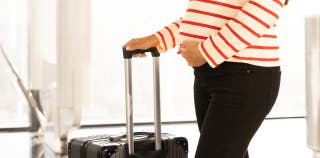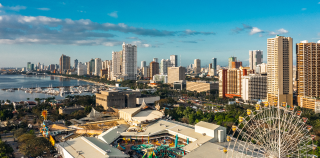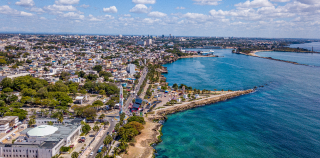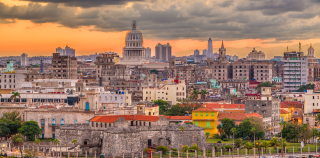- You’re not required to purchase travel insurance to visit the Philippines, but you should purchase a policy anyway.
- Our top picks for travel insurance for a trip to the Philippines come from Tin Leg, Seven Corners, and Generali Global Assistance.
- It’s especially important to have travel medical insurance because US private insurance and Medicare will not work in the Philippines.
- In addition to medical emergencies, travel insurance can also protect you against flight delays, trip interruptions, loss of luggage, and other unexpected events.
- We recommend using an online comparison tool to find the right travel insurance to suit your needs for your trip to the Philippines. This way, you can compare multiple quotes and coverage options at once and get the best deal.
On This Page
- Key takeaways
- Is travel insurance required to visit the Philippines?
- Our top picks for the best Philippines travel insurance
- Philippines travel information & requirements
- What does travel insurance for the Philippines cover?
- What isn’t covered by travel insurance for the Philippines?
- How much does travel insurance for the Philippines cost?
- How to get the best Philippines travel insurance
- FAQ: Philippines travel insurance
- Related topics
On This Page
- Key takeaways
- Is travel insurance required to visit the Philippines?
- Our top picks for the best Philippines travel insurance
- Philippines travel information & requirements
- What does travel insurance for the Philippines cover?
- What isn’t covered by travel insurance for the Philippines?
- How much does travel insurance for the Philippines cost?
- How to get the best Philippines travel insurance
- FAQ: Philippines travel insurance
- Related topics
Philippines Travel Insurance: Coverage Requirements & Costs
Our top picks for the best philippines travel insurance
Our top picks for the best Philippines travel insurance
Tin Leg
Seven Corners
Generali Global Assistance
Is travel insurance required to visit the Philippines?
Travel insurance isn’t legally required to visit the Philippines. However, we strongly recommend that you buy travel insurance before your trip. Your US health insurance will not be valid during your vacation to the Philippines. A travel insurance policy minimizes your losses in the event of a medical emergency or other covered event.
Our top picks for the best Philippines travel insurance
Best Rated Travel Insurance
Tin Leg
Why We Like It
PROS
- Excellent primary coverage for medical expenses
- High limit for emergency evacuation coverage
- Optional cancel for any reason (CFAR) coverage available
- Comes with coverage for hurricanes and inclement weather
- Coverage for pre-existing conditions is available if purchased within 14 days of the trip deposit
CONS
- Baggage delay coverage requires a 24-hour waiting period
- Low coverage limits for baggage and personal effects
Best Value for Medical Emergencies
Seven Corners
Why We Like It
PROS
- Offers coverage for pre-existing conditions
- Money-back guarantee
- Cancellation & Interruption coverage standard
- Covers action sports & equipment
CONS
- Cancel for any reason not included standard
- Must meet waiver for pre-existing conditions to be covered
Best Value Travel Insurance
Generali Global Assistance
Why We Like It
PROS
- Lowest cost of all Generali Global Assistance plans
- 24/7 emergency travel assistance included
- Telemedicine included
CONS
- Lower coverage than other Generali plans
- Pre-existing conditions are not covered by the Standard plan
- No coverage for accidental death and dismemberment during on-land travel
Philippines travel information & requirements
Here’s an overview of what you can expect when traveling to the Philippines
| Query | Detail |
|---|---|
| Tourist visa required? | Not required for trips lasting 30 days or less |
| Passport requirements | Must have a valid U.S. passport with at least 6 months remaining until the expiration date |
| Local currency | Philippine peso |
| Average 5-year exchange rate | 1 USD = 52.15 PHP |
| Vaccine requirements | Not required unless you’re traveling from a country known for yellow fever transmission |
| COVID test required? | No |
| Travel advisory level | Level 2 - Exercise Increased Cautio |
| Emergency services phone number | 911 |
| Accepts U.S. health insurance? | No |
Do I need a visa to travel to the Philippines?
You don’t need a visa to travel to the Philippines unless you plan to stay there for more than 30 days.
Do I need a passport to visit the Philippines?
Yes. You must have a passport that’s valid for at least six months after your travel date
COVID-19 requirements
All travel restrictions related to COVID-19 have been lifted. You don’t have to present proof of vaccination, test for COVID-19, or quarantine yourself upon arrival in the Philippines.
What does travel insurance for the Philippines cover?
Travel insurance for the Philippines covers a wide range of circumstances.
It’s important to understand that some travel insurance policies may be more comprehensive and cover more potential issues than others. The following is a breakdown of standard coverages, but you should always review a provider’s plan to ensure you’re comfortable with the coverage.
Trip cancellation insurance
When you’re excited about a trip, the last thing you want to do is cancel it. Unfortunately, you may have to cancel your trip to the Philippines due to circumstances outside your control. For example, if a close family member passes away a few days before you’re set to depart, you may have to cancel to attend the funeral.
Trip cancellation insurance reimburses you for the prepaid, nonrefundable portion of your trip. This includes hotel accommodations, flights, and prepaid bookings. To qualify for reimbursement, you must cancel the trip for a covered reason. Many companies allow you to cancel due to illness, job loss, or the death of your travel companion.
If you’re concerned about trip cancellation, consider purchasing cancel for any reason (CFAR) insurance. This type of coverage reimburses a significant portion of your prepaid expenses.
Trip delay insurance
Trip delay insurance reimburses you for additional expenses associated with common carrier delays. In travel lingo, a common carrier is a company that offers transportation services to the public as part of its business model. Airlines, railroads, bus companies, and ferries are all examples of common carriers that may be covered by this type of travel insurance.
Once you purchase trip delay insurance, read the policy carefully. You won’t be reimbursed for additional expenses unless the delay lasts for a specific amount of time. For example, you probably won’t qualify for reimbursement due to a 30-minute delay, but you may qualify if your flight is delayed by six hours or more.
This type of coverage reimburses you only for necessary expenses. You can’t go out and buy a new wardrobe, but your insurance company may reimburse you for accommodations, transportation to and from your hotel, meals, toiletries, medication, and other personal items.
Trip interruption insurance
Like trip cancellation insurance, trip interruption coverage reimburses you for prepaid, nonrefundable expenses. The difference is that it only reimburses you if you start your trip and have to end it early for a covered reason. For example, if your travel companion has a heart attack while you’re in the Philippines, your travel insurance may reimburse you for the unused portion of your hotel stay.
Travel medical insurance
Even if you’ve never had any medical problems, there’s always a chance that you’ll develop one during your visit to the Philippines. Travel health insurance covers the cost of lab tests, X-rays, surgery, and other types of medical care, ensuring you don’t have to pay the whole bill yourself.
Medical evacuation insurance
Many types of travel insurance also include medical evacuation coverage, which pays to transport you to the nearest suitable medical facility in an emergency. Let’s say you’re climbing one of the many volcanoes in the Philippines when you fall and break several bones. If you’re in a remote area, the nearest adequate hospital maybe 50 miles away.
Baggage insurance
No one wants to arrive in the Philippines and discover that their luggage is missing or damaged. Unfortunately, it’s possible for a common carrier to lose one of your bags or damage it during the handling process. Thieves also target travelers, which may leave you without your favorite piece of jewelry or the dress you purchased just for your trip.
This type of travel insurance usually covers baggage loss and baggage delays. If you bring two suitcases to the airport and only get one upon your arrival to the Philippines, your travel insurance should reimburse you for the missing bag. Note that many travel insurance plans have per-item and per-person limits.
Baggage delay coverage reimburses you for certain expenses if your bag doesn’t arrive as scheduled. This type of coverage doesn’t kick in right away, so don’t assume that you can buy a new outfit just because your bag is an hour late. The purpose of baggage delay coverage is to reimburse you for the money you spend replacing certain items. For example, if you have to buy shampoo, bar soap, toothpaste, and a toothbrush, your travel insurance should reimburse you for these expenses.
Rental car coverage
Many types of travel insurance also cover rental car damage and theft. For example, if you accidentally hit the curb while trying to park on a busy street in the Philippines, your travel insurance may pay to repair the scratch. If you get into an accident, your travel insurance may cover the cost of repairs or reimburse the rental company for the fair market value of the car, whichever costs less.
What isn’t covered by travel insurance for the Philippines?
Although travel insurance covers you in many situations, it doesn’t cover every possible emergency.
-
Pre-existing conditions:
In most cases, travel insurance doesn’t cover pre-existing health conditions. These are conditions that you have on or before the date you book your trip. For example, if you’ve had chronic kidney disease for 20 years, CKD is a pre-existing condition. This type of coverage won’t pay your medical expenses if you experience a complication of kidney disease while traveling in the Philippines. -
Risky activities:
If you plan to climb volcanoes, go skydiving or engage in other risky activities, check with your insurance agent first. Many plans exclude coverage for adventure sports and other high-risk activities, so you may need to purchase extra insurance if you’re a bit of a daredevil. -
Known storms:
Travel insurance generally doesn’t cover you if you experience an emergency due to a known storm. For example, if there’s a storm brewing in the South China Sea, your insurer may deny your claim if you choose to travel to the Philippines anyway. -
Foreseeable events:
Your travel insurance may not cover you if you experience a loss due to a foreseeable event. This is an event that a reasonable person could have predicted.
How much does travel insurance for the Philippines cost?
According to official sales data from Squaremouth, travel insurance for the Philippines costs, on average, around $197.20 for an average trip.
Our official sales figures over the past year show that our customers paid an average of $181.36 for travel insurance to the Philippines.
For basic medical coverage for your trip to the Philippines, travel insurance can cost as little as $1 per day. For a more comprehensive policy that includes trip cancellation and trip interruption coverage, you can expect to pay around $9 to $11 per day for insurance.
To give you a better understanding of how much travel insurance for the Philippines cost, we got sample quotes from some popular travel insurance providers.
We used these travel details for our quotes:
- Age: 35 years old
- Destination: Philippines
- Trip Length: 7 days
- Trip cost: $2,000
This first table shows four quotes for basic travel insurance coverage.
Example Where Plan Doesn’t Reimburse the Full Trip Cost
| Provider | Plan Name | Plan Cost | Cancellation / Interruption Limits | Medical / Medevac Limits |
|---|---|---|---|---|
| Tin Leg | Standard | $5 | $0 / $0 | $30,000/ $200,000 |
| Trawick International | Safe Travels Explorer | $26 | $0 / $0 | $50,000/ $200,000 |
| Seven Corners | Trip Protection Basic | $25 | $0 / $1,000 | $100,000 / $250,000 |
| AXA Assistance USA | Silver | $42 | $0 / $500,000 | $25,000 / $100,000 |
To have financial protection in case your trip is canceled or interrupted, you’ll need more comprehensive coverage. For this next table, we got four quotes that show the cost of coverage which includes trip cancellation and trip interruption insurance.
Example Where Plan Does Reimburse the Full Trip Cost
| Provider | Plan Name | Plan Cost | Cancellation / Interruption Limits | Medical / Medevac Limits |
|---|---|---|---|---|
| Tin Leg | Standard | $64 | $2,000 / $3,000 | $30,000/ $200,000 |
| Trawick International | Safe Travels Explorer | $61 | $2,000 / $2,000 | $50,000/ $200,000 |
| Seven Corners | Trip Protection Basic | $75 | $2,000 / $2,000 | $100,000 / $250,000 |
| AXA Assistance USA | Silver | $69 | $2,000 / $2,000 | $25,000 / $100,000 |
Several factors affect the cost of travel insurance:
-
Age:
The younger you are, the less it costs to buy coverage for your upcoming trip. This is because older people have a higher risk of accidents and illnesses. -
Destination:
Some destinations are riskier than others. Insurers charge more to provide coverage for trips to those destinations. -
Trip price:
The more your trip costs, the more coverage you need. It costs extra to extend your coverage.
How to get the best Philippines travel insurance
To get the best travel insurance for your trip to the Philippines, follow these tips:
-
Consider what type of coverage you need:
Evaluate the risks you face when traveling. If you plan to do any adventure activities, you should consider a plan that includes extra coverage. -
Check to see what coverage you get with your credit card:
If you book your trip with your credit card, you may already receive some types of coverage, such as trip cancellation and interruption. Once you know what you already have, you can then decide what additional types of protection you want. -
Compare plans and providers:
Request multiple quotes and take the time to compare them. Make sure you understand each plan and what it requires for reimbursement. To easily compare coverage options, try using our online comparison tool. -
Purchase a policy early:
If you purchase your travel insurance soon after making your initial trip deposit, you may be able to get a better deal.
FAQ: Philippines travel insurance
Do I need travel insurance to visit the Philippines?
Although you’re not required to purchase Philippines travel insurance, we strongly recommend that you purchase this type of coverage. The right insurance plan can prevent you from losing thousands of dollars.
What does travel insurance cover in the Philippines?
It depends on what type of policy you buy. The most basic insurance plans usually cover medical expenses, medical evacuation, unexpected delays, trip cancellations, and trip interruptions. You can also buy travel insurance that covers your baggage and your rental vehicle.
How much is Philippines travel insurance?
Philippines travel insurance can cost as little as $1 per day for the most basic policy. For a more comprehensive plan, you can expect to pay around $9 to $11 per day.
Can I use my U.S. insurance in the Philippines?
U.S. health insurance doesn’t cover medical expenses incurred in the Philippines. This includes Medicare, Medicaid, military insurance plans, and private health insurance.
Can U.S. citizens get free health care in the Philippines?
The Philippines has a public health system, but non-citizens aren’t eligible for free health care. Therefore, it’s important to purchase health insurance designed to cover medical emergencies in other countries. If you don’t have travel health insurance, you may end up owing thousands of dollars in medical expenses.






























































